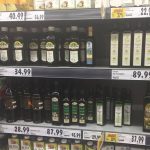Still, low yields will mean higher imports.
The yield is lower than in an average year, up to 30 percent less compared to last year, but the quality of olive oil this year will be exceptional, say Croatian olive growers who have in recent days gone to their olive groves for harvest. Just a few months ago, they were worried about what the drought had done to their olives. But, after the rains in September, olive growers in Dalmatia are now much more optimistic, The only reason for sadness are all those burnt trees around Žrnovnica and other parts of Dalmatia, which are reminders of this summer’s numerous wildfires, reports Večernji List on October 25, 2017.
“What can we say, it was a catastrophe. Even though, according to the statements issued by the ministry, the olive growers who have lost everything should have been compensated, nothing has happened,” said Milan Amižić, president of the Oblica Association from Žrnovnica, who hopes that everyone will draw a lesson from this summer’s fires.
“All that has happened to us is due to systematic negligence, neglected forests and agricultural land. It is time for a new concept of management and prevention, greater engagement of advisory services and the Croatian Forests public company, but also for the tax on unused agricultural land,” said Amižić, who lost 90 olive trees in the fires.
In Dalmatia, it seems that the average percentage of oil will not be below 16 percent, which means not less than 16 litres per 100 kilograms of olives. But, it growers would systematically analyse the ripeness of their olive trees, instead of starting harvest just because their neighbours have done it, yields would be even better.
Rade Bobanović from Polača describes this year as an above-average in quality of oil from organic olive groves. Due to the drought, no pests have developed, but the yield in the hinterland of Zadar and at the level of the whole Croatia is 25 to 30 percent lower than usual. Most severe problems were caused by rains and high temperatures at the time of flowering of trees in May.
Expectations are that Croatian olive growers will this year produce 4.5 million litres of oil, compared to the annual average of 6 to 6.5 million, of which about 30 percent is used for personal consumption, while about 15 percent is estimated to end up in the “grey market” zone. With new olives which are planned to be planted and which should increase the number of olive trees to 10 million, in several years Croatia should become self-sufficient an become able to provide more significant quantities of oil for export. At present, Croatia does not have enough oil for its population, although an average Croat consumes just two litres per year.
According to data from the Croatian Chamber of Commerce, last year, when oil production was at an average level, Croatia imported around 4,200 tons of oil worth 15.5 million euros and exported about 240 tons of premium oil worth around two million euros. This year, we can expect even higher import, because of which it is likely that prices of local oil will not increase significantly.
In Dalmatia, the price will be similar to last year, between 70 and 100 kunas per litre, while oil from Istria will reach up to 160 kunas. “The reason is not better quality of Istrian oil, but because Istria has branded its products better and has not lowered prices for the last 10 to 15 years,” said Bobanović.
Translated from Večernji List.








